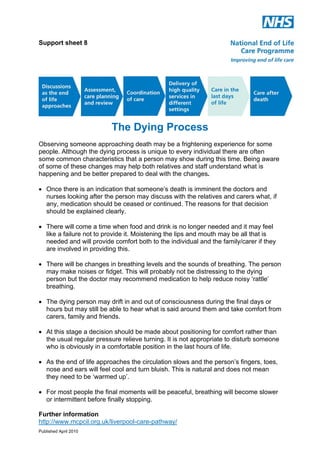
Support Sheet 8: The Dying Process
- 1. Support sheet 8 The Dying Process Observing someone approaching death may be a frightening experience for some people. Although the dying process is unique to every individual there are often some common characteristics that a person may show during this time. Being aware of some of these changes may help both relatives and staff understand what is happening and be better prepared to deal with the changes. ! Once there is an indication that someone’s death is imminent the doctors and nurses looking after the person may discuss with the relatives and carers what, if any, medication should be ceased or continued. The reasons for that decision should be explained clearly. ! There will come a time when food and drink is no longer needed and it may feel like a failure not to provide it. Moistening the lips and mouth may be all that is needed and will provide comfort both to the individual and the family/carer if they are involved in providing this. ! There will be changes in breathing levels and the sounds of breathing. The person may make noises or fidget. This will probably not be distressing to the dying person but the doctor may recommend medication to help reduce noisy ‘rattle’ breathing. ! The dying person may drift in and out of consciousness during the final days or hours but may still be able to hear what is said around them and take comfort from carers, family and friends. ! At this stage a decision should be made about positioning for comfort rather than the usual regular pressure relieve turning. It is not appropriate to disturb someone who is obviously in a comfortable position in the last hours of life. ! As the end of life approaches the circulation slows and the person’s fingers, toes, nose and ears will feel cool and turn bluish. This is natural and does not mean they need to be ‘warmed up’. ! For most people the final moments will be peaceful, breathing will become slower or intermittent before finally stopping. Further information http://www.mcpcil.org.uk/liverpool-care-pathway/ Published April 2010